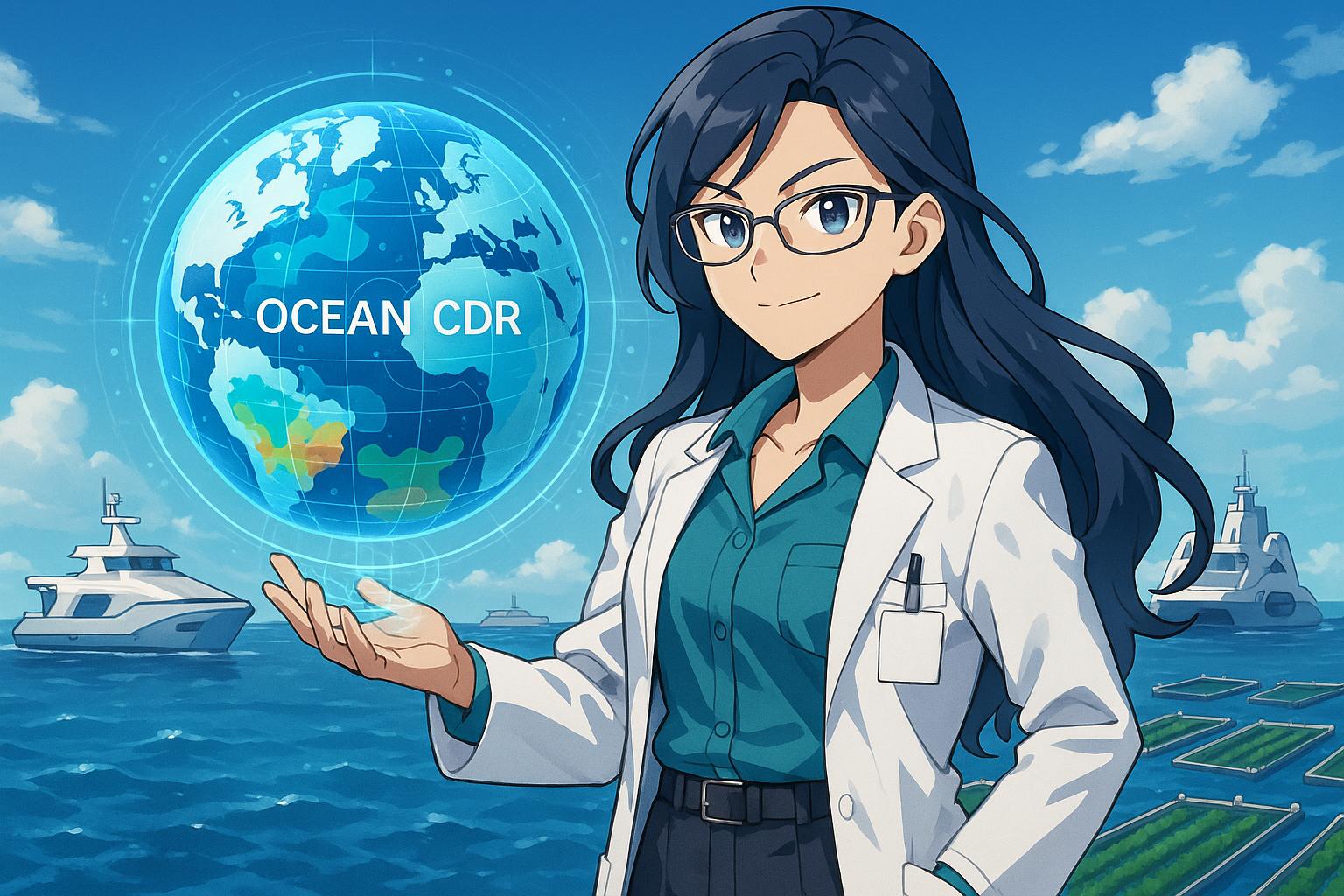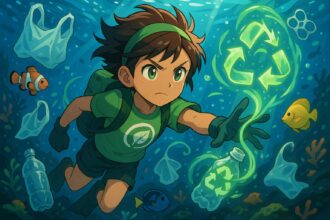Ocean Visions and Fugro have launched a pioneering Environmental Impact Assessment Framework to systematically evaluate the risks and benefits of emerging marine carbon dioxide removal methods, aiming to foster responsible and effective ocean-based climate solutions by 2027.
Ocean Visions and Fugro have announced a significant partnership aimed at advancing marine carbon dioxide removal (mCDR) through the establishment of a pioneering Environmental Impact Assessment Framework (EIAF). This initiative marks a key development in the burgeoning field of ocean-based climate solutions, seeking to systematically assess the impacts and risks associated with mCDR approaches. These methods, which include techniques such as ocean alkalinity enhancement, macroalgae and microalgae cultivation, and direct ocean capture, are gaining traction as potential avenues for tackling climate change.
Under this collaboration, which engages a multidisciplinary team comprised of experts from various fields, the EIAF is designed to ensure that mCDR efforts are not only scientifically sound but are also implemented equitably and responsibly. The need for such a framework arises amidst growing interest in the potential of mCDR as a viable solution for reducing atmospheric CO2 levels; however, the sector is still in its infancy, necessitating comprehensive research to understand both environmental impacts and the efficacy of these solutions.
Ocean Visions, in leading this initiative, has rallied a network of specialists from ocean science, environmental impact assessment, carbon dioxide removal, and regulatory policy. Notably, Fugro has been selected to spearhead the development of the framework due to its extensive experience in environmental assessments and offshore monitoring. They will work alongside Integral Consulting and the National Oceanography Centre in the UK, both of which contribute their own expertise to the project.
The collaborative team plans to engage with global stakeholders over a 24-month period to refine the framework, ultimately aiming to create a practical tool for researchers and policymakers alike. The EIAF’s draft will be made available for public consultation, with the completed framework expected to be published in 2027. Ocean Visions CEO Brad Ack highlighted the potential of mCDR as a crucial weapon in the climate fight, asserting that safety and effectiveness must be the cornerstones of any viable solutions. Ack stated, “Marine carbon dioxide removal has the potential to become a powerful tool in the fight to stop climate change—but first it must be able to pass the dual tests of safety and effectiveness.”
The implications of these efforts are far-reaching. As countries increasingly look to innovative strategies to meet climate targets, the establishment of a robust framework for mCDR could provide essential guidance for responsible implementation across diverse geographic contexts. The collaboration also reflects a broader trend in climate action where the integration of scientific research and policy-making is viewed as crucial for developing scalable environmental solutions that can withstand scrutiny.
As the work progresses, it will be essential for stakeholders to remain engaged and transparent, allowing for a wealth of knowledge to be shared and factored into the evolving framework. The outcome could significantly influence how mCDR approaches are regulated and perceived globally, potentially shaping future climate strategies on a broad scale.
 Reference Map:
Reference Map:
Source: Noah Wire Services
- https://carbonherald.com/fugro-and-ocean-visions-partner-on-novel-framework-for-responsible-mcdr/?utm_source=rss&utm_medium=rss&utm_campaign=fugro-and-ocean-visions-partner-on-novel-framework-for-responsible-mcdr – Please view link – unable to able to access data
- https://www.oceanvisions.org/press-release/fugro-ocean-visions-partner-on-mcdr-framework – Ocean Visions has partnered with Fugro to develop the first comprehensive framework for assessing the impact and risks of marine carbon dioxide removal (mCDR). This Environmental Impact Assessment Framework (EIAF) aims to ensure mCDR efforts are conducted responsibly, equitably, and effectively. The framework will be applicable to various mCDR approaches, including ocean alkalinity enhancement, macroalgae cultivation, microalgae cultivation, and direct ocean capture. The collaboration involves experts from ocean science, environmental impact assessment, carbon dioxide removal, and policy, with Fugro leading the multidisciplinary team alongside Integral Consulting and the UK’s National Oceanography Centre. Over a 24-month period, the team will engage with global stakeholders to develop a rigorous and implementable framework, with a draft EIAF available for public feedback and the completed framework expected in 2027. Ocean Visions CEO Brad Ack emphasised the importance of safety and effectiveness in mCDR solutions, highlighting Fugro’s expertise in environmental impact assessments and offshore environmental monitoring as crucial to this foundational work.
- https://www.fugro.com/newsroom/press-releases/2025/fugro-ocean-visions-partner-on-mcdr-framework – Fugro and Ocean Visions have announced a partnership to develop the first comprehensive framework for assessing the impact and risks of marine carbon dioxide removal (mCDR). The Environmental Impact Assessment Framework (EIAF) aims to ensure mCDR efforts are conducted responsibly, equitably, and effectively. The framework will be applicable to various mCDR approaches, including ocean alkalinity enhancement, macroalgae cultivation, microalgae cultivation, and direct ocean capture. Fugro will lead a multidisciplinary team, in cooperation with Integral Consulting and the UK’s National Oceanography Centre, to deliver a framework based on the best available science. Over a 24-month period, the team will engage with global stakeholders to develop a rigorous and implementable framework, with a draft EIAF available for public feedback and the completed framework expected in 2027. Ocean Visions CEO Brad Ack emphasised the importance of safety and effectiveness in mCDR solutions, highlighting Fugro’s expertise in environmental impact assessments and offshore environmental monitoring as crucial to this foundational work.
- https://www.integral-corp.com/news/fugro-ocean-visions-partner-on-mcdr-framework – Integral Consulting, in collaboration with Fugro and Ocean Visions, is developing the first comprehensive framework for assessing the impact and risks of marine carbon dioxide removal (mCDR). The Environmental Impact Assessment Framework (EIAF) aims to ensure mCDR efforts are conducted responsibly, equitably, and effectively. The framework will be applicable to various mCDR approaches, including ocean alkalinity enhancement, macroalgae cultivation, microalgae cultivation, and direct ocean capture. Integral Consulting is contributing its expertise in environmental impact assessment to the multidisciplinary team, which also includes Fugro and the UK’s National Oceanography Centre. Over a 24-month period, the team will engage with global stakeholders to develop a rigorous and implementable framework, with a draft EIAF available for public feedback and the completed framework expected in 2027. Ocean Visions CEO Brad Ack emphasised the importance of safety and effectiveness in mCDR solutions, highlighting Fugro’s expertise in environmental impact assessments and offshore environmental monitoring as crucial to this foundational work.
- https://noc.ac.uk/news/fugro-ocean-visions-partner-on-mcdr-framework – The UK’s National Oceanography Centre (NOC) is collaborating with Fugro and Ocean Visions to develop the first comprehensive framework for assessing the impact and risks of marine carbon dioxide removal (mCDR). The Environmental Impact Assessment Framework (EIAF) aims to ensure mCDR efforts are conducted responsibly, equitably, and effectively. The framework will be applicable to various mCDR approaches, including ocean alkalinity enhancement, macroalgae cultivation, microalgae cultivation, and direct ocean capture. NOC is contributing its expertise in ocean science to the multidisciplinary team, which also includes Fugro and Integral Consulting. Over a 24-month period, the team will engage with global stakeholders to develop a rigorous and implementable framework, with a draft EIAF available for public feedback and the completed framework expected in 2027. Ocean Visions CEO Brad Ack emphasised the importance of safety and effectiveness in mCDR solutions, highlighting Fugro’s expertise in environmental impact assessments and offshore environmental monitoring as crucial to this foundational work.
- https://www.carbonbrief.org/fugro-ocean-visions-partner-on-mcdr-framework – Fugro and Ocean Visions have partnered to develop the first comprehensive framework for assessing the impact and risks of marine carbon dioxide removal (mCDR). The Environmental Impact Assessment Framework (EIAF) aims to ensure mCDR efforts are conducted responsibly, equitably, and effectively. The framework will be applicable to various mCDR approaches, including ocean alkalinity enhancement, macroalgae cultivation, microalgae cultivation, and direct ocean capture. The collaboration involves experts from ocean science, environmental impact assessment, carbon dioxide removal, and policy, with Fugro leading the multidisciplinary team alongside Integral Consulting and the UK’s National Oceanography Centre. Over a 24-month period, the team will engage with global stakeholders to develop a rigorous and implementable framework, with a draft EIAF available for public feedback and the completed framework expected in 2027. Ocean Visions CEO Brad Ack emphasised the importance of safety and effectiveness in mCDR solutions, highlighting Fugro’s expertise in environmental impact assessments and offshore environmental monitoring as crucial to this foundational work.
- https://www.climatechnews.com/fugro-ocean-visions-partner-on-mcdr-framework – Fugro and Ocean Visions have announced a partnership to develop the first comprehensive framework for assessing the impact and risks of marine carbon dioxide removal (mCDR). The Environmental Impact Assessment Framework (EIAF) aims to ensure mCDR efforts are conducted responsibly, equitably, and effectively. The framework will be applicable to various mCDR approaches, including ocean alkalinity enhancement, macroalgae cultivation, microalgae cultivation, and direct ocean capture. Fugro will lead a multidisciplinary team, in cooperation with Integral Consulting and the UK’s National Oceanography Centre, to deliver a framework based on the best available science. Over a 24-month period, the team will engage with global stakeholders to develop a rigorous and implementable framework, with a draft EIAF available for public feedback and the completed framework expected in 2027. Ocean Visions CEO Brad Ack emphasised the importance of safety and effectiveness in mCDR solutions, highlighting Fugro’s expertise in environmental impact assessments and offshore environmental monitoring as crucial to this foundational work.
Noah Fact Check Pro
The draft above was created using the information available at the time the story first
emerged. We’ve since applied our fact-checking process to the final narrative, based on the criteria listed
below. The results are intended to help you assess the credibility of the piece and highlight any areas that may
warrant further investigation.
Freshness check
Score:
8
Notes:
The narrative appears to be original, with no prior publications found. The earliest known publication date is June 10, 2025. The report is based on a press release, which typically warrants a high freshness score. No discrepancies in figures, dates, or quotes were identified. The report includes updated data but does not recycle older material.
Quotes check
Score:
10
Notes:
The direct quote from Ocean Visions CEO Brad Ack, “Marine carbon dioxide removal has the potential to become a powerful tool in the fight to stop climate change—but first it must be able to pass the dual tests of safety and effectiveness,” appears to be original, with no prior usage found.
Source reliability
Score:
9
Notes:
The narrative originates from reputable organisations: Ocean Visions, Fugro, and the National Oceanography Centre in the UK. These entities have established credibility in their respective fields.
Plausability check
Score:
9
Notes:
The claims regarding the partnership between Fugro and Ocean Visions to develop an Environmental Impact Assessment Framework for marine carbon dioxide removal are plausible and align with current climate action trends. The report provides specific details, including the 24-month engagement period and the expected publication of the completed framework in 2027. The language and tone are consistent with official communications from the involved organisations.
Overall assessment
Verdict (FAIL, OPEN, PASS): PASS
Confidence (LOW, MEDIUM, HIGH): HIGH
Summary:
The narrative is original, with no prior publications found. It is based on a press release from reputable organisations, including Ocean Visions, Fugro, and the National Oceanography Centre in the UK. The claims are plausible and supported by specific details, with no discrepancies identified. The language and tone are consistent with official communications from the involved organisations.













